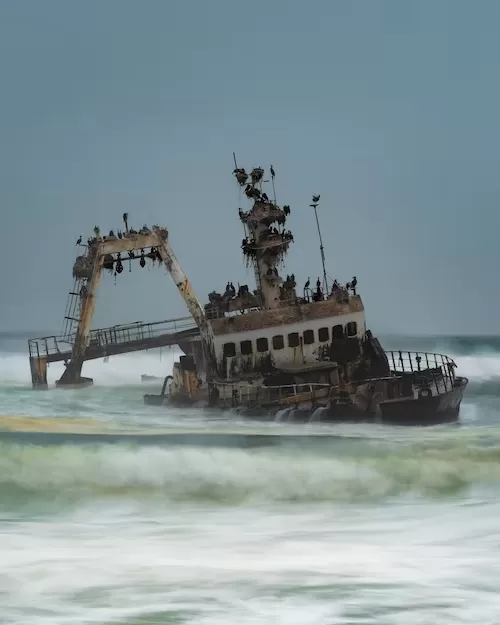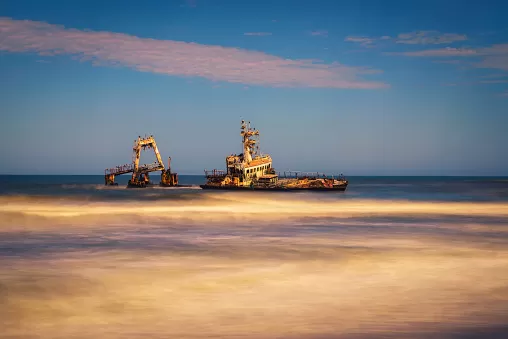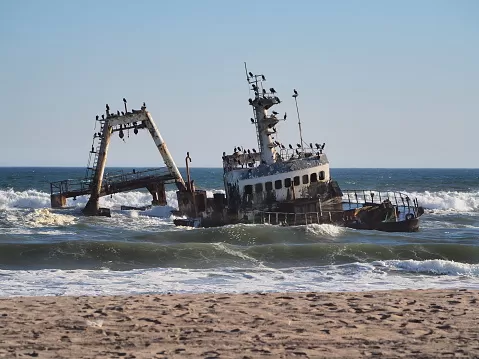One of the most hostile and wildest coastal stretch of Namibia which has seen and still counting tours worth visiting is the Namibia Skeleton Coast.
The Skeleton Coast which resonates an atmosphere of the rusted remains of wrecked ships that is surrounded by swirling mists and make for moody and dramatic visuals can be located in the northern part of the Atlantic coast of Namibia and south of Angola from the Kunene River south to the Swakop River, although the name is sometimes used to describe the entire Namib Desert coast.
Why is Namibia called the Skeleton Coast?

The famous name “Skeleton Coast” was coined by John Henry Marsh as the title for the book he wrote chronicling the shipwreck of the Dunedin Star. Since the book was first published in 1944, it has become so well known that the coast is now generally referred to as Skeleton Coast and is given that as its official name on most maps today.
One of the oldest shipwrecks in the Skeleton Coast region is the wreck near the town of Oranjemund which was wrecked during the 1530s. It is known to be one of the oldest discovered shipwrecks of the Iberian Atlantic tradition in Sub-Saharan Africa.
On Thursday 22 March 2018, a Japanese registered fishing vessel, MVF Fukuseki Maru, got into trouble and ran aground near Durissa Bay, south of the Ugab River mouth, about 200 km from Walvis Bay, lying 2 km from the Skeleton Coast beach. All 24 foreign crew members were rescued by Namibian authorities.
Historically, the indigenous San people, also called the Bushmen in the interior region of Namibia “The Land God Made in Anger”, where the Portuguese sailors also referred to it as “The Gates of Hell”. On the coast, the upwelling of the cold Benguela current gives rise to dense ocean fogs (called cassimbo by the Angolans) for much of the year.
The winds blow from land to sea, rainfall rarely exceeds 10 millimetres (0.39 in) annually and the climate is highly inhospitable. There is constant heavy surf on the beaches. In the days before engine-powered ships and boats, it was possible to get ashore through the surf but impossible to launch from the shore. The only way out was by going through a marsh hundreds of kilometres long and only accessible via a hot and arid desert.
The coast is largely soft sand occasionally interrupted by rocky outcrops. The southern section consists of gravel plains, while north of Terrace Bay the landscape is dominated by high sand dunes. Skeleton Bay is now known as a great location for surfing. The Saltyjackal, a surf camp located in Swakopmund, Namibia, is currently the only group that runs guided surf trips along the Skeleton Coast.
The area’s name derives from the whale and seal bones that once littered the shore from the whaling industry, although in modern times the coast harbours the skeletal remains of the shipwrecks caught by offshore rocks and fog. More than a thousand such vessels of various sizes litter the coast, notably the Eduard Bohlen, Benguela Eagle, Otavi, Dunedin Star and Tong Taw.
Past human occupation by Strandlopers is shown by shell middens of white mussels found along parts of the Skeleton Coast.

Namibia has declared the 16,000 square kilometres (6,200 sq mi) Skeleton Coast National Park over much of the area, from the Ugab River to the Kunene. The northern half of the park is a designated wilderness area.
Notable features are the clay castles of the Hoarusib River, the Agate Mountain salt pans and the large seal colony at Cape Fria. The remainder of the coast is the National West Coast Recreation Area. The national park would be part of the proposed Iona – Skeleton Coast Transfrontier Conservation Area.
The coast has been the subject of a number of wildlife documentaries, particularly concerning adaptations to extreme aridity, including the 1965 National Geographic documentary Survivors of the Skeleton Coast.
Many of the plant and insect species of the sand dune systems depend on the thick sea fogs which engulf the coast for their moisture and windblown detritus from the interior as food. The desert bird assemblages have been studied in terms of their thermoregulation, coloration, breeding strategies and nomadism.
The riverbeds further inland are home to baboons, giraffes, lions, black rhinoceros, spotted and brown hyena, as well as springbok. The animals get most of their water from wells dug by the baboons or elephants. The black rhinoceros population was the main reason why the CBBC show Serious Desert was filmed in the region.
Thank you for reading this article.
Related articles
Namibia Africa: A Beautiful Destination To Visit
Namib Desert| Interesting Facts And Things To Know
Travel Guide To Tanzania And Top Things To know
The Top Things To Do And See In Harare Zimbabwe

